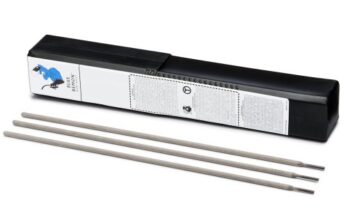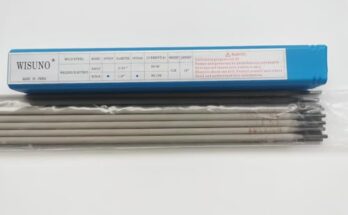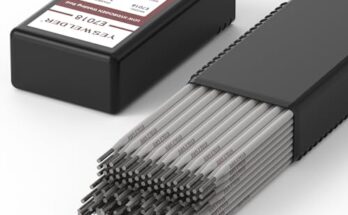Need to tackle a tough welding job? Understanding the right tools is crucial. This guide will teach you everything you need to know about the e7016 welding rod, from its properties and applications to troubleshooting common issues.
The E7016 is a low-hydrogen, iron-powder electrode designed for welding steel in various
positions. The “E” signifies it’s an electrode, “70” indicates its tensile strength (70,000 psi), and “16” specifies its performance characteristics. It’s specifically designed for excellent weld penetration and a smooth, consistent bead, even in difficult-to-reach areas like overhead welding. This makes it a versatile choice for many professional welders and serious DIY enthusiasts. I remember first using E7016 on a particularly challenging pipe welding project; its performance in the vertical up position was a game-changer. It allowed for a much cleaner and faster weld compared to other electrodes I’d used previously. The iron powder helps achieve this superior penetration, allowing for a strong weld with less effort.
Key Features and Benefits of E7016
The E7016 boasts several key advantages. Its low-hydrogen formulation minimizes the risk of porosity and cracking in the weld, resulting in a stronger, more reliable joint. The iron powder in the coating enhances arc stability and provides superior penetration. This translates to less spatter, meaning a cleaner work area and less cleanup time, a significant benefit for any welding project. This, coupled with its ease of use, makes it ideal for both experienced and novice welders. For example, I used E7016 to weld some rusted-through sections on my old truck’s frame; the deep penetration and smooth bead made for a structurally sound repair. The low spatter also kept my mess to a minimum, even while working in a cramped space under the chassis.
Comparing E7016 to Other Welding Rods
Compared to other electrodes like E6013, E7018, and E7024, the E7016 stands out with its versatility and superior penetration. The E6013 is easier to use for beginners, but it lacks the penetration power of the E7016. The E7018, while also low-hydrogen, is typically used for critical applications requiring extremely high strength, making it less versatile for general-purpose work. The E7024 offers good penetration but is less suited for vertical up welding. Think of it like choosing the right tool for a job: a screwdriver is fine for most things, but a specialized wrench is needed for specific tasks. The E7016 is that reliable, versatile wrench in the welder’s toolbox.
Applications of E7016 Welding Rods
Welding Steel in Various Positions
The E7016 excels in welding steel in all positions: flat, horizontal, vertical, and overhead. Its consistent arc and penetration make it suitable for a wide range of applications, from simple repairs to complex structural work. This versatility is a major selling point. Many other electrodes struggle with overhead welding, producing weak or uneven welds. However, the E7016’s consistent arc helps maintain a smooth bead even when welding overhead. The ability to weld effectively in all positions saves time and effort on diverse projects.
Repairing and Fabricating Steel Structures
Because of its ability to penetrate rusty or contaminated metal effectively, the E7016 is a fantastic choice for repairing damaged steel structures, like the aforementioned truck frame repair. Its low-hydrogen characteristics ensure a strong and reliable weld, even on surfaces that are less than perfect. This makes it ideal for restoration projects, automotive repairs, and various other industrial applications.
Construction and Maintenance Applications
In the construction and maintenance industries, where speed and quality are paramount, the E7016’s reliability makes it a valuable asset. Its superior penetration and reduced spatter translate to increased efficiency and reduced cleanup time. Many contractors rely on the E7016 for its consistent performance and the confidence it offers in various welding tasks. It’s the kind of rod you can trust to get the job done, whether you’re building a new structure or repairing an existing one.
E7016 Welding Rod: Technical Specifications
Understanding the AWS Classification
The American Welding Society (AWS) classification system helps welders understand the properties and characteristics of various electrodes. The E7016 classification provides a wealth of information about the electrode’s capabilities. It tells us the tensile strength, the type of current, and its suitability for various welding positions. Understanding this classification is fundamental for selecting the right electrode for the specific job.
Electrode Composition and Coating
The E7016 electrode consists of a steel core wire and a special coating that provides arc stability and shielding. The coating contains various compounds designed to minimize hydrogen, improve penetration, and reduce spatter. This precisely balanced composition results in a weld with high strength and excellent quality. The coating is carefully engineered to ensure consistent performance and to help create a strong, reliable weld.
Tensile Strength and Other Mechanical Properties
The tensile strength of a weld is a measure of its resistance to being pulled apart. The “70” in E7016 indicates a tensile strength of 70,000 psi, making it suitable for many structural applications. Other mechanical properties, such as yield strength and ductility, also contribute to the overall quality and reliability of the weld. Understanding these properties helps welders choose the right electrode for specific structural requirements.
Welding Techniques with E7016
Proper Welding Setup and Preparation
Before starting any welding project, proper preparation is crucial. This includes cleaning the surfaces to be welded, selecting the appropriate amperage for the electrode and material thickness, and ensuring proper ventilation. Neglecting these steps can lead to poor weld quality and potentially hazardous situations. I’ve learned through experience that a little extra preparation goes a long way in ensuring a successful weld. It saves time and frustration in the long run.
Maintaining a Consistent Arc Length
Maintaining a consistent arc length is essential for achieving a smooth, consistent weld bead. Too short of an arc can lead to excessive spatter, while too long an arc can result in an uneven weld. Practice is key to mastering this technique, and experience helps develop the feel for the right arc length. This is where the iron powder coating of the E7016 really shines – it helps keep that arc stable.
Troubleshooting Common Issues
Problems like porosity, cracking, or excessive spatter can occur if the welding parameters aren’t properly controlled. Understanding the causes of these issues is crucial for troubleshooting and correcting them. Careful attention to amperage, arc length, and proper surface preparation can prevent most common problems. For instance, insufficient amperage might result in poor penetration, while excessive amperage might lead to excessive spatter.
Safety Precautions When Using E7016
Personal Protective Equipment (PPE)
Welding is inherently hazardous, and proper personal protective equipment (PPE) is essential. This includes a welding helmet with appropriate shade lenses to protect your eyes, welding gloves to protect your hands, and flame-resistant clothing to protect your skin. Never underestimate the importance of safety gear; it can prevent serious injuries.
Ventilation and Fumes
Welding fumes can be harmful to your health, so adequate ventilation is crucial. Work in a well-ventilated area or use a fume extractor to remove harmful gases and particles from the air. Exposure to welding fumes can lead to long-term health problems, so protecting yourself is paramount.
Fire Hazards
Welding can ignite flammable materials, so be aware of your surroundings and take necessary precautions to prevent fires. Keep a fire extinguisher nearby, and ensure that flammable materials are kept a safe distance from the welding area.
Choosing the Right E7016 Welding Rod
Factors to Consider When Selecting an Electrode
When choosing an E7016 welding rod, several factors need to be considered. These include the material thickness, the welding position, and the desired weld quality. Understanding these factors helps choose the right electrode for the specific application. The diameter of the electrode will also affect the amperage needed and the speed at which you can weld.
Different Manufacturers and Their Products
Several manufacturers produce E7016 welding rods, each with slightly varying characteristics. Researching different brands and comparing their specifications can help you make an informed decision based on your specific needs and preferences. Reading reviews and comparing prices are also good strategies to find the best value for your money.
Where to Buy E7016 Welding Rods
E7016 welding rods are readily available from various sources, including welding supply stores, online retailers, and hardware stores. Shopping around for the best prices and selecting a reputable supplier is important to ensure the quality of the product.
Applications Across Industries
Automotive Repair and Fabrication
The E7016 is a common choice for automotive repair and fabrication due to its versatility and ability to weld in various positions. Its strength and reliability make it ideal for repairing damaged components or fabricating custom parts.
Construction and Manufacturing
In the construction and manufacturing sectors, where structural integrity is critical, the E7016’s high tensile strength and low-hydrogen properties make it a reliable choice for welding steel structures.
Industrial Maintenance and Repair
In industrial settings, the E7016 is widely used for maintenance and repair work due to its ease of use and ability to create strong, reliable welds, even on rusty or contaminated surfaces.
Frequently Asked Questions
What is E7016 welding rod best for?
E7016 welding rods are best suited for welding steel in all positions, particularly where high penetration and a smooth, consistent weld bead are required. They excel in applications requiring a strong, reliable weld, even on rusty or contaminated surfaces. They are a great choice for repairs and fabrications where quality and strength are critical. Learn more about specific applications in construction and automotive repair.
What is the difference between E7016 and E6013?
While both are used for general-purpose steel welding, E7016 offers superior penetration and is better suited for all-position welding, including overhead. E6013 is easier to use for beginners but produces weaker welds and struggles in overhead positions. E7016 is more versatile and suited for structurally critical applications.
Can E7016 weld aluminum?
No, E7016 is specifically designed for steel welding. Aluminum requires a different type of electrode and welding process. Using E7016 on aluminum would produce a weak, unreliable joint and may even damage your equipment.
What amperage should I use with E7016?
The appropriate amperage depends on the electrode diameter and the thickness of the metal being welded. Consult the manufacturer’s specifications for recommended amperage ranges. Generally, thicker metal and larger diameter electrodes require higher amperage.
How important is proper electrode storage for E7016?
Proper storage is crucial to maintain the low-hydrogen properties of E7016. Keep the rods dry and in their original packaging to prevent moisture absorption, which can lead to porosity and cracks in the weld.
What are the safety precautions when using E7016?
Always wear appropriate PPE, including a welding helmet, gloves, and flame-resistant clothing. Ensure adequate ventilation to remove welding fumes. Keep flammable materials away from the welding area, and have a fire extinguisher nearby.
What happens if I use the wrong amperage with E7016?
Using incorrect amperage can lead to several problems, including poor penetration (too low), excessive spatter (too high), or an inconsistent weld bead. Always refer to the manufacturer’s specifications for the recommended amperage range for your specific electrode and material thickness.
Final Thoughts
The E7016 welding rod is a versatile and reliable tool for any welder’s arsenal. Its ability to produce high-quality welds in various positions, along with its superior penetration and low-hydrogen characteristics, make it suitable for a wide range of applications. By understanding its properties, applications, and proper welding techniques, you can confidently tackle many welding projects, from simple repairs to complex fabrications. Remember, safety is paramount, so always prioritize using proper PPE and working in a safe environment. Mastering the E7016 can significantly enhance your welding skills and allow you to achieve professional-quality results on your next project. So grab your welding gear, choose the right E7016 electrode, and get ready to build something amazing!


